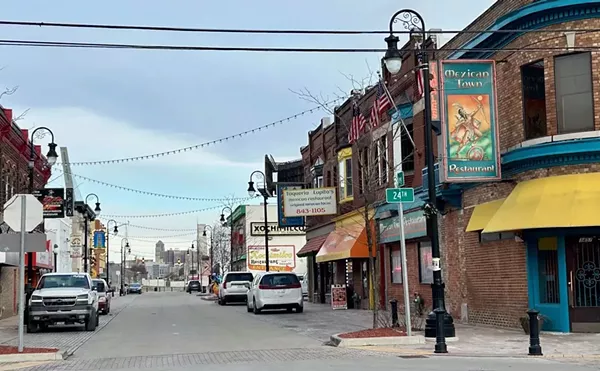A couple of years ago I was in the crowd gathered for the Nain Rouge parade out on Canfield Street. Shinola was open and I wandered in. There was a vendor selling a few edibles. I bought a hot chocolate. It was really good, apparently some kind of gourmet concoction that treated my taste buds royally.
While there I looked over the Shinola wares. I appreciated that there was a nice store in newly upscale Midtown. I'd lived in the Cass Corridor years earlier when none of that was possible.
About a year later a former Detroiter was visiting town and I took him to Midtown to show him our shiny new jewel of a district. We went into Shinola. A store employee greeted us inside. I explained to him that we weren't going to buy anything and I was just showing my friend around. We began walking around the space. Another employee came from the back of the store somewhere and asked if we needed any help. I told him the same thing I told the white guy.
Then he just stood there and stared at us. I had the feeling he had been called out to keep an eye on us as potential shoplifters. After a couple of minutes, feeling uncomfortable, we left.
I don't blame the brother for staring us down. You know, just doing his job and all. It was a minor happening, but it echoes stories I'm hearing more and more around Detroit. Black people aren't feeling as welcome in certain areas of the city as redevelopment and gentrification take hold. This has come up before, and I've been at two meetings the past few weeks where that topic has been discussed.
Change is always difficult, and as the face and makeup of Detroit changes, the issue will be part of the dynamic. It's kind of ironic. Many white people fled the city for fear of black people moving into their neighborhoods and causing the value of their property to drop. Their money and the tax base fled with them, and the value of our property dropped.
There were a lot of things stoking that, not the least of which were real estate companies. Ironically, now white people have rediscovered the city partly because property values are so low in comparison to just about everywhere else. There's a new generation ready to take their chances in Detroit. That's fine. I welcome the chance to live in a vibrant, diverse city.
The truth is that I'm not particularly mad at Shinola and I'm glad it's there. I understand that running a business is challenging and they've probably had to deal with thieves. But the moment touched me in a similar way I'm hearing about from others.
Mostly I'm pretty good at not scaring the white people — despite my unruly dreadlocks. I greet people, smile, and try not to touch a lot of things in stores. And if I'm not going to buy something I tell folks straight up that I'm just looking.
But why do I feel like I have to be careful not to scare the white people? To a certain extent it's part of growing up black. But there are times when you want to let your guard down and just be who you are.
"Mostly I'm pretty good at not scaring the white people — despite my unruly dreadlocks."
tweet this
That's a concern that Lauren Hood, director of the Live6 Alliance, has been addressing head on as she works to help developments along the Six Mile Road corridor from Livernois to Wyoming, and tie it to the beginning-to-boom Avenue of Fashion at Livernois and Seven Mile Road. Hood hopes to maintain a dynamic in which local residents feel more like they are a part of what is going on as new people and new businesses arrive on the scene. To create a community where the economy is vibrant and it's OK to be black.
To that end, Live6 has been having a series of "Speakeasy" conversations to bring residents and institutions together and discuss issues before they become problems.
"I think what is most important is for people to see each other," Hood said at a recent Speakeasy. "People doing development work in institutions kind of see community as some amalgamous blob, and they're not really seeing it as a group of individual people."
Maybe that's what's happening in Midtown. I don't know what all the dynamics are, I just know that there are levels of discomfort on all sides. That's not necessarily always bad. Maybe a little discomfort can help prod people to move past issues. That is if people want to get past them.
The Live6 neighborhood has vastly different dynamics than Midtown. While there are universities, University of Detroit Mercy and Marygrove are much smaller than Wayne State University. The comparison stops there. There are no huge institutions such as the cultural and medical centers.
What Live6 does have are residential neighborhoods, so maybe development there will naturally be more inclusive of the people who were there before the developers showed up. Nobody is building half-million-dollar condos there yet. I doubt that as many folks on the west side will be pushed out in the way they have been downtown. But you never know. There was an entirely different dynamic in the Cass Corridor 30 years ago.
"The neighborhood is about to change very quickly and I think that the way that the community interacts with the institutions is going to play a big role in what the outcomes are and who they benefit," Hood said at the Speakeasy.
One thing Live6 does have is that it's right down the street from the Avenue of Fashion. I live near there in Green Acres. It was pretty much an exclusive white neighborhood when I was a kid. When I moved in some 20 years ago it had become a mostly middle-class black neighborhood. Now it's moving the other way. The most recent new residents on my block have been white, including a designer who works at Shinola. That's fine. We all get along pretty well.
Things have been picking up along the Avenue the last few years. We've got new stores and restaurants opening regularly — especially restaurants. The 1917 American Bistro is an upscale place that seems to be doing well. Kuzzo's Chicken & Waffles has quickly become a neighborhood favorite, and I know that a lot of people are anticipating the new Bucharest Grill location that is being fixed up. Even Motor City Brewing Works is rehabbing a building to occupy along with Slyde, a sliders and soup eatery.
None of this can be successful by making black people feel uncomfortable in those spaces. It's not that I'm advocating for separate black and white spaces of the city. That's the way things were long ago but the black business and entertainment district was destroyed when I-75 was constructed right through the middle of it in 1959.
There are plenty of white people on the west side and a visible presence of black-owned businesses in Midtown — and ultimately we all have to live here. But there are dynamics at play that would be best worked out if we are going to live well and prosper.







